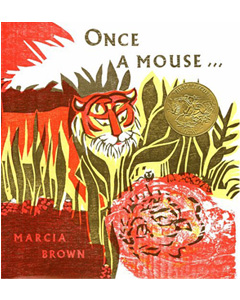Once a Mouse
Once a Mouse is a children's book written and illustrated by Marcia Brown. Published in 1961, it is a notable example of children's literature that has been praised for its storytelling and illustrations. The book is a retelling of a traditional Indian fable that teaches lessons about gratitude and the dangers of taking others for granted.
Plot Summary[edit | edit source]
The story of Once a Mouse unfolds in ancient India, where a kind and magical hermit lives in the forest. One day, he comes across a small mouse that is in danger of being eaten by a predator. To save the mouse, the hermit uses his magical powers to transform it into a cat. However, the cycle of danger continues as the cat faces threats from larger animals. To protect it, the hermit transforms the cat into a dog, and then the dog into a tiger, each time saving it from its current predator.
As the tiger, the former mouse becomes arrogant and forgets its humble beginnings, even threatening the hermit who saved its life. In a twist of fate, the hermit decides to teach the ungrateful tiger a lesson by turning it back into a mouse, reminding it of its true nature and the kindness it once received.
Themes and Analysis[edit | edit source]
Once a Mouse presents themes of humility, gratitude, and the importance of remembering one's origins. It explores the consequences of pride and ingratitude, especially when one forgets the kindness of others. The story serves as a moral lesson for children, emphasizing the value of being thankful for the help one receives and recognizing the potential dangers of pride and arrogance.
The book also delves into the concept of transformation, both literal and metaphorical, as the mouse undergoes physical changes that reflect its internal journey and ultimate realization of its mistakes.
Illustrations[edit | edit source]
Marcia Brown's illustrations in Once a Mouse are highly regarded for their detail and the way they complement the story's themes. Using a technique that mirrors the traditional art styles of India, Brown's illustrations add depth to the narrative and help transport readers to the ancient setting of the tale. The artwork plays a crucial role in storytelling, enhancing the magical and moral elements of the book.
Reception and Awards[edit | edit source]
Once a Mouse received widespread acclaim upon its publication. It was awarded the Caldecott Medal in 1962, recognizing it as the most distinguished American picture book for children published that year. The book has been praised for its moral lesson, engaging story, and beautiful illustrations, making it a beloved classic in children's literature.
Legacy[edit | edit source]
The impact of Once a Mouse extends beyond its initial publication. It is considered a classic of children's literature and continues to be used as a teaching tool in educational settings. The book's themes of humility and gratitude remain relevant, making it a timeless tale for readers of all ages.
Search WikiMD
Ad.Tired of being Overweight? Try W8MD's physician weight loss program.
Semaglutide (Ozempic / Wegovy and Tirzepatide (Mounjaro / Zepbound) available.
Advertise on WikiMD
|
WikiMD's Wellness Encyclopedia |
| Let Food Be Thy Medicine Medicine Thy Food - Hippocrates |
Translate this page: - East Asian
中文,
日本,
한국어,
South Asian
हिन्दी,
தமிழ்,
తెలుగు,
Urdu,
ಕನ್ನಡ,
Southeast Asian
Indonesian,
Vietnamese,
Thai,
မြန်မာဘာသာ,
বাংলা
European
español,
Deutsch,
français,
Greek,
português do Brasil,
polski,
română,
русский,
Nederlands,
norsk,
svenska,
suomi,
Italian
Middle Eastern & African
عربى,
Turkish,
Persian,
Hebrew,
Afrikaans,
isiZulu,
Kiswahili,
Other
Bulgarian,
Hungarian,
Czech,
Swedish,
മലയാളം,
मराठी,
ਪੰਜਾਬੀ,
ગુજરાતી,
Portuguese,
Ukrainian
Medical Disclaimer: WikiMD is not a substitute for professional medical advice. The information on WikiMD is provided as an information resource only, may be incorrect, outdated or misleading, and is not to be used or relied on for any diagnostic or treatment purposes. Please consult your health care provider before making any healthcare decisions or for guidance about a specific medical condition. WikiMD expressly disclaims responsibility, and shall have no liability, for any damages, loss, injury, or liability whatsoever suffered as a result of your reliance on the information contained in this site. By visiting this site you agree to the foregoing terms and conditions, which may from time to time be changed or supplemented by WikiMD. If you do not agree to the foregoing terms and conditions, you should not enter or use this site. See full disclaimer.
Credits:Most images are courtesy of Wikimedia commons, and templates Wikipedia, licensed under CC BY SA or similar.
Contributors: Prab R. Tumpati, MD

